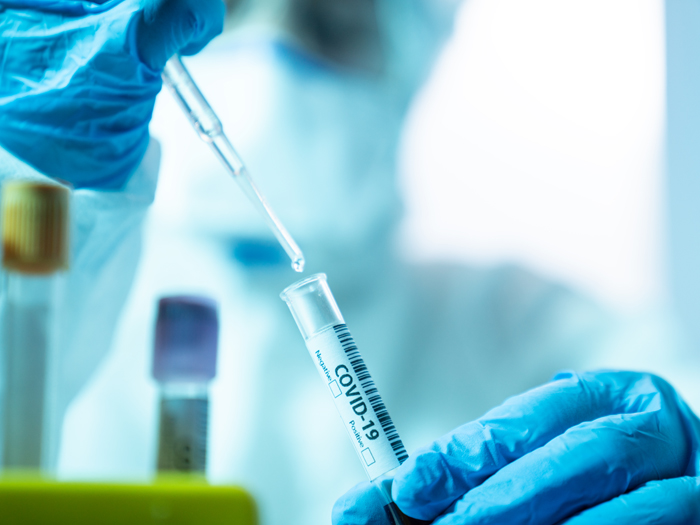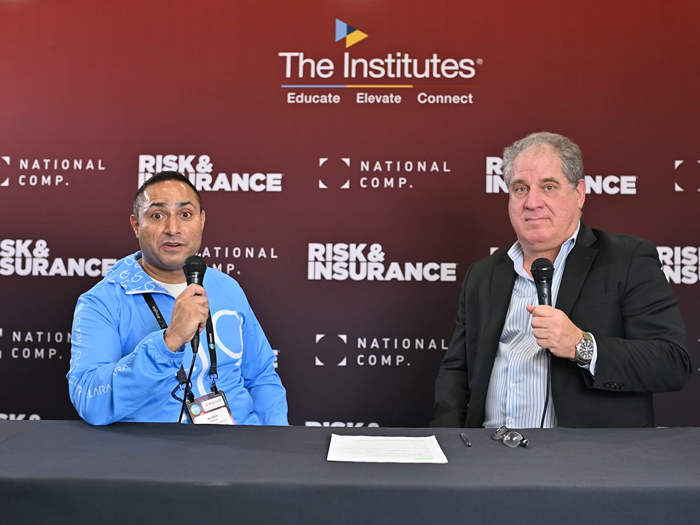6 Ways COVID-19 Testing Could Unexpectedly Rattle Your Insurance Program

While testing for COVID-19 in the workplace isn’t yet required by any federal or state mandates, that could easily change as cases surge anew.
With or without a mandate though, many employers are utilizing testing programs as part of a broader strategy to keep workers safe.
A testing program, however, should be undertaken with caution, with a full analysis of the ways it could potentially touch your insurance program.
During “COVID-19 Testing in the Workplace: What You Need to Know Before Testing Begins,” a cross-practice webinar presented by law firm Perkins Coie, attorney Selena Linde, a partner in the firm’s D.C. office, outlined the various policies that could be affected by a testing program and noted strategies for maximizing coverage and navigating renewals.
She also emphasized the importance of having an insurance incident response program in place.
Linde advises employers to engage in a critical review of their insurance portfolio and contracts before launching a testing program. Here are six key areas where organizations might find gaps or potential insurance issues.
1) Vendor Contracts
If you do select a vendor for testing or screening, you’re going to want to pay attention to how those vendor contracts are formed, Linde said.
If a claim arises, some liability may rest with the employer and some with the vendor. It’s important to ensure that coverage is in place for both.
“You’ll need to determine whether or not to list any vendors as additional insureds. Some contracts will require you to,” the attorney explained. “And if you do, it’s going to have a major impact on your tower of insurance. So be very careful. Look at the contracts. That is a very critical consideration.”
2) Commercial General Liability
CGL typically provides broad coverage for claims involving bodily injury, property damage or personal injury, which can include certain privacy violations.
It may also can contain coverage for claims such as wrongful detention.
“We’ve already seen claims come out of areas where testing has begun, for emotional distress from false positive [results],” said Linde, citing a case that involved an employee with elderly parents.
“The person then isolated but lived with elderly parents and claimed multiple damages for emotional distress to themselves, to their elderly parents, for the cost of the hotel for the 14 days and for the costs associated with other relatives being tested.”
Many of these claims are likely to be covered under a CGL policy, unless the policy has a communicable disease or virus exclusion, Linde said.
“So, before you embark on any testing, review your policy and have a conversation with your insurer. If you do have these exclusions, we’ve been successful in having some carriers remove exclusions and add additional endorsements onto current policies.”
3) Employment Practices Liability
Linde said her firm is also seeing EPL claims in for harassment, discrimination and wrongful termination.
These claims often arise when testing is not universal across a company, Linde said. In one case, an employer was testing those who worked in cubicles but not those working in individual offices.
“As a result, the lower-level staff were all required to have testing while upper management staff were not. That did not sit well.”
Linde said the firm is also seeing claims for racial discrimination based on how testing was implemented, as well as claims for harassment and wrongful termination for individuals that refused testing and were then terminated.
“Make sure that before embarking on any type of testing, one — you have the coverage, and two — if you go this route, that you don’t do it in a way that could be seen as discriminatory in any way.”
Wage and hour violation claims are also arising in cases where employees are not compensated for time spent testing, particularly if the time required is onerous.
“We’re seeing those come in from [places like] warehouses where sometimes there were there was a wait of over two hours in the heat,” she said.
“You’re going to continue to see issues surrounding that.”
4) Cyber and Privacy
Attorneys are also seeing claims arise privacy and data issues that come along with the collection of medical data.
“Some cyber privacy policies have specific HIPAA exclusions,” said Linde
“Be very careful, before embarking on testing, that you have this endorsed so that you can provide medical HIPAA testing and have a discussion with your carrier.
“There is coverage available for this, but organizations that normally would need no medical information may have it excluded under their policies. So, take another look at that when you’re reviewing your language,” she added.
Not all employers will opt to collect the data that comes from testing or screening. Some employers may do temperature checks before employees can enter the premises but not record the results.
Even in those cases, privacy could be a concern, and any medical information relayed to the employee should be done in a private setting.
5) Workers’ Compensation
The state regulated workers’ comp system — and the ever-changing landscape of presumption laws — present special challenges for testing programs, including questions surrounding whether it’s compensable if someone sustains an injury during testing.
State regulations related to COVID-19 are being updated on a daily basis, said Linde, putting a heavy burden on employers with multi-state operations.
“There is ongoing coronavirus information related to how workers’ comp applies, being put out by states on a daily basis. You’ll need to … be reviewing those websites regularly to see how it’s changing with respect to COVID-19 testing.”
Right now, she said, the general consensus is that “if you were required to test as part of your employment, it would be arising out of or in the course of employment. And if there were injuries, that would be covered by workers’ comp.”
6) Property
While most organizations will not run into testing issues that could affect their property policies, the possibility does exist, so it’s important to double-check, said Linde.
“Make sure that there’s no limitation of use, on site or in the parking lot, with respect to any medical testing. It’s rare that this would be a problem under property policies, but since it’s in a few of them, you do need to check.”
Have an Insurance Incident Response Plan
With state regulations related to COVID-19 claims in a state of flux for some time to come, the most important thing organizations can do is be prepared, said Linde.
“We highly recommend that every company have a COVID-19 insurance incident response plan,” she said, which should include a clear chain of communication.
Linde said one of the most critical issues keeping policyholders from maximizing their insurance is communication regarding whether or not the insurance will respond — before the insurance carrier has been notified.
“Carriers will automatically, at the very beginning of a coverage fight, send out discovery requests on all of the communications surrounding the incident,” she said.
“Be careful. After Hurricane Katrina and after 9/11, this was a major [factor in coverage losses]. Carriers were able to look back at the intent of the policyholder and to find information that actually ended up hurting their chances of maximizing their insurance claim.
“No one within the company should be opining on whether or not the coverage [applies to] a particular a particular factual situation without the general counsel, outside counsel or a legal representative from within your company being on that email,” Linde said.
“These are questions that are legal issues and that are not cut and dried. Please, please, please have a communication chain,” said Linde.
If an incident related to COVID-testing arises, there should be a specific point of contact within the legal department. While executives, risk management, HR and other functions must communicate about claims, those communications should be directed by a legal representative for the organization.
Appropriate forms should be readily available.
Organizations can ask their legal department to create forms or use forms found online. A number of medical facilities that offer testing are offering incident forms that can be sent directly to the company’s legal representative in the event of a claim.
“If you decide to use a medical provider’s template, review it. You’re going to want to make sure that it has enough detail on the timeline of events, the individuals that were present,” and that it directs the collection of any photographs or evidence at that testing location at the time the incident occurred, she added.
Linde also recommends leaving cameras at the testing site. That way if an incident occurs, photos can be taken quickly and added to documentation. Consent forms for photos should also be available to be signed and added to the file.
“Documentation is key. The expenses, medical expenses, anything that comes in from a particular claimant. And any questions that you ask that claimant, [communications] that go back and forth, need to be kept in a separate and individual file.
Linde suggests having a separate checklist for each policy addressing how cooperation is handled with that particular carrier, along with notes on what could be considered an interrelated claim, and the time frame required to provide notice.
“Notice is critical, and this is another area where policyholders often lose their coverage,” said Linde.
“You need to be on top of it. There are templates that your company should have in your incident response plan that [specify] exactly who to notify and when.
As renewals come around, Linde advises organizations to be prepared for changes, and to put in the work to ensure underwriters have the full picture of the testing program that’s in place or under consideration.
“Right now, we don’t have an end in sight for the coronavirus, and it’s likely that your company will still be dealing with this pandemic upon your next insurance renewal. Insurers are understandably still incredibly nervous and looking for ways to lower the risks, and they’ve already put in certain COVID-19 exclusions,” said Linde.
“It is more important than ever in this coming year to start your renewal process early. We recommend starting at least four months early, but quite frankly five [is better], because the time you take with the underwriters will determine whether or not they’re willing to leave the COVID-19 exclusions out of your policy.
“Clients that we’ve counseled in the last couple of months spent the time with underwriters and walked through what their protocol was going to be, what their incident response plan was, and how they were going to handle reopening. Those are the clients who were able to secure coverage that did not have new COVID-19 exclusions.” &











